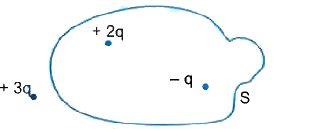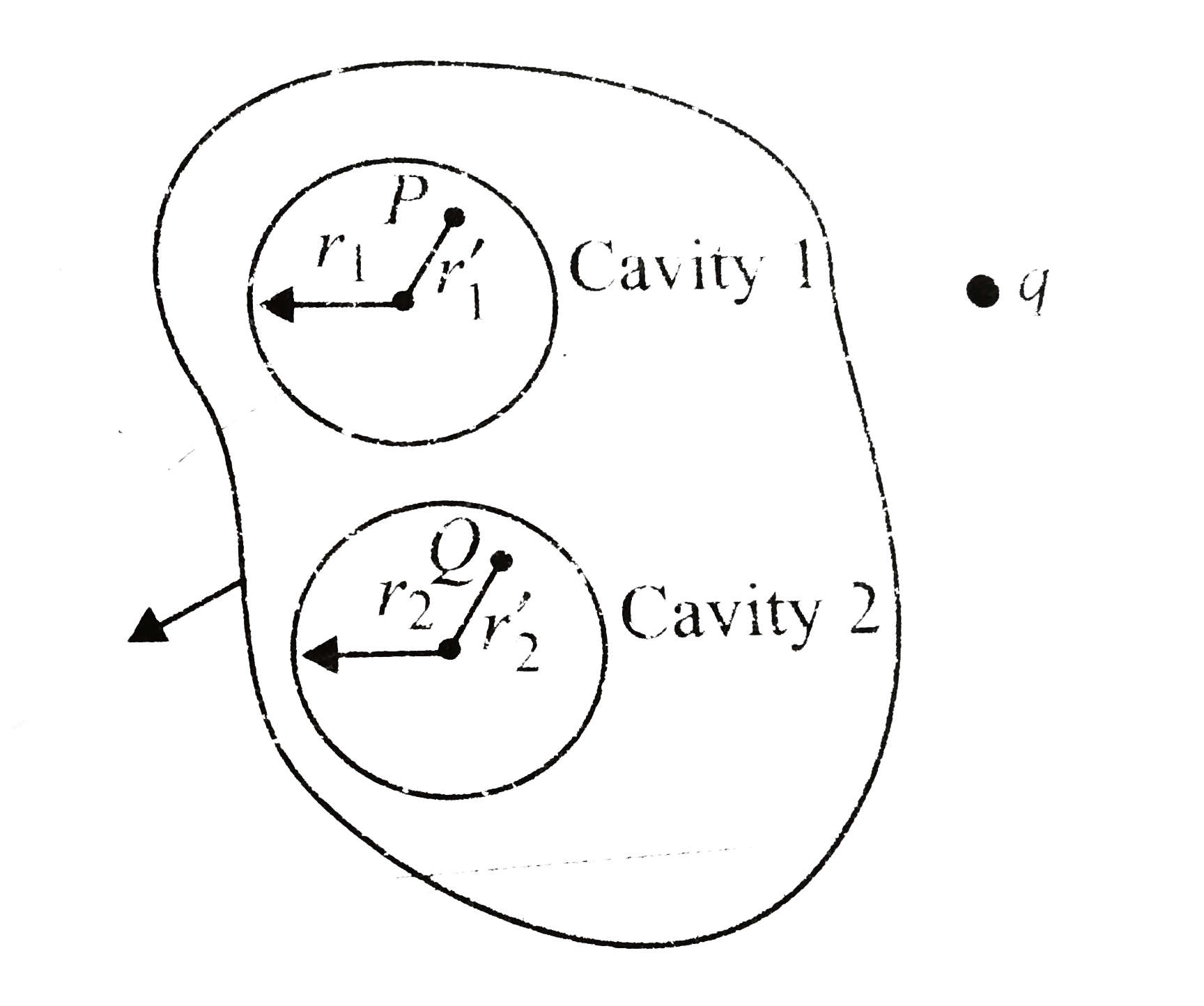A charge q is inside a closed surface and charge -q is outside. The out going electric flux is
−q/∈0
zero
q/∈0
2q/∈0
The correct Answer is:C
To solve the problem of finding the outgoing electric flux when a charge q is inside a closed surface and a charge −q is outside, we can follow these steps:
1. Understand the Concept of Electric Flux:
Electric flux (ΦE) through a closed surface is defined by Gauss's Law, which states that the electric flux through a closed surface is proportional to the net charge enclosed within that surface. Mathematically, it is given by:
ΦE=Qencϵ0
where Qenc is the total charge enclosed by the surface and ϵ0 is the permittivity of free space.
2. Identify the Charges:
In this scenario, we have:
- A charge q inside the closed surface.
- A charge −q outside the closed surface.
3. Determine the Enclosed Charge:
Since the charge −q is outside the closed surface, it does not contribute to the electric flux through the surface. Therefore, the only charge that contributes to the electric flux is the charge q that is inside the surface.
4. Apply Gauss's Law:
According to Gauss's Law, we can calculate the electric flux through the closed surface as follows:
ΦE=qϵ0
5. Final Result:
The outgoing electric flux through the closed surface is:
ΦE=qϵ0
Electric flux (ΦE) through a closed surface is defined by Gauss's Law, which states that the electric flux through a closed surface is proportional to the net charge enclosed within that surface. Mathematically, it is given by:
ΦE=Qencϵ0
where Qenc is the total charge enclosed by the surface and ϵ0 is the permittivity of free space.
In this scenario, we have:
- A charge q inside the closed surface.
- A charge −q outside the closed surface.
Since the charge −q is outside the closed surface, it does not contribute to the electric flux through the surface. Therefore, the only charge that contributes to the electric flux is the charge q that is inside the surface.
According to Gauss's Law, we can calculate the electric flux through the closed surface as follows:
ΦE=qϵ0
The outgoing electric flux through the closed surface is:
ΦE=qϵ0
Topper's Solved these Questions
- ELECTROSTATICSBook:MOTIONChapter:ELECTROSTATICSExercise:Exercise - 2 (Objective Problems | NEET)
Explore 64 Videos
- ELECTROSTATICSBook:MOTIONChapter:ELECTROSTATICSExercise:Exercise -3 Section (A)
Explore 41 Videos
- ELECTROSTATICSBook:MOTIONChapter:ELECTROSTATICSExercise:SELF PRACTICE PROBLEM
Explore 27 Videos
- ELECTRONICS - SEMI CONDUCTORBook:MOTIONChapter:ELECTRONICS - SEMI CONDUCTORExercise:EXERCISE - 3
Explore 29 Videos
- ELECTROSTATICS - I Book:MOTIONChapter:ELECTROSTATICS - I Exercise:EXERCISE - 4 (Level -II) PREVIOUS YEAR - JEE ADVANCED
Explore 13 Videos
Similar Questions
There is a point charge +q inside a hollow sphere and a point charge -q just outside its surface. The total flux passing through the surface of sphere is :
View SolutionCharge q1 is inside the Gaussain surface , charge q2 just outside the surface. Does the electric flux through the surface.Does the electric flux through the surface depend on q1 ? Does it depend on q2 ? Explain.
View Solution
Knowledge Check
A charge q is enclosed as shown below the electric flux is
 Amaximum inBmaximum inCmaximum inDequal in all
Amaximum inBmaximum inCmaximum inDequal in allA charge q is enclosed as shown, below the electric flux is
 Amaximum in (i)Bmaximum in (i)Cmaximum in (iii)Dequal in all
Amaximum in (i)Bmaximum in (i)Cmaximum in (iii)Dequal in allA closed surface is vacumm encloses charges −qand+3q. Another charge −2q lies outside the surface. Total electric flux over the surface is
AzeroB2q/∈0C−3q∈0D4π/∈0
Show three points charges +2q. -q and +3q, Two charges +2q and -q are enclosed within a surface 'S' What is the electric flux due to this configuration through the surface 'S' ?

View SolutionA charge Q is enclosed by a Gaussian surface. If surface area is doubled and charge Q is tripled then the outward electric flux will
View SolutionA point charge q1 is placed inside cavity 1 and another point charge q2 is inside cavity 2. A point charge q is placed outside the conductor. For the situation described above, answer the following questions.

The charge on outer surface of the conductor would be
View SolutionA point charge q1 is placed inside cavity 1 and another point charge q2 is inside cavity 2. A point charge q is placed outside the conductor. For the situation described above, answer the following questions.
If charge q2 is at point Q (inside cavity 2), then →E at the center of cavity 2 due to induced charge on the surface of cavity 2 would be
View SolutionA point charge q1 is placed inside cavity 1 and another point charge q2 is inside cavity 2. A point charge q is placed outside the conductor. For the situation described above, answer the following questions.
→E inside the conductor at point S distant r from point charge q, due to charge on outer surface of the conductor, would be
View Solution